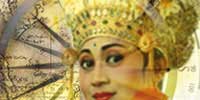|
JAKARTA (indo.com): The Indonesian cultural treasury is
vast, with almost all aspects of human life being manifested,
practiced, marketed in a diversity of ways by the country's
hundreds of ethnic groups. One of these manifestations is
personal adornment in the form of jewelry.
Jewelry is the product of human culture, the result of an
idea, feeling, skill, perseverance and creativity. It is
not static, but progresses with the progression of time
and therefore provides clues to the lifestyle of a given
time in history.
The art of making jewelry is known throughout the archipelago,
practiced by each ethnic group in its own particular way.
Thus, local nuances deriving from ethnic traditions, the
outlook on life, symbolic values and the foreign influences
that have reached the area have given immense diversity
to the world of Indonesian jewelry, and yet amongst all
this diversity we can catch glimmers of similarity. In all
aspects of Indonesian life, the national motto of "Bhineka
Tunggal Ika", or Unity in Diversity, is very much a reality.
History
People throughout the world have always worn some form of
jewelry, for religious purposes and traditional ceremonies,
as amulets, status symbols and beauty enhancers. Since prehistoric
times, Southeast Asians, including the Indonesians, have
been acquainted with jewelry and jewelry-making techniques.
 During
the hunting and food-gathering (Mesolithic) age, Indonesians
began to live more settled lives. They made their homes
in caves and produced tools for practical purposes as well
as objects required for the burial of their dead. They also
had the technology to make necklaces of shells and animals'
bones, which they perforated with simple drills so that
they could be strung together. During
the hunting and food-gathering (Mesolithic) age, Indonesians
began to live more settled lives. They made their homes
in caves and produced tools for practical purposes as well
as objects required for the burial of their dead. They also
had the technology to make necklaces of shells and animals'
bones, which they perforated with simple drills so that
they could be strung together.
Jewelry-making skills had improved by the time of the agricultural
age, or neolithicum. New immigrants arrived from the mainland,
bringing new ideas and technologies which allowed the production
of finger-rings, necklaces and bracelets from clay, semi-precious
stones, iron and gold. Design continued to be simple, with
some geometrical figurations.
With the metal age came the skill of mixing metals. Copper
was combined with tin to produce bronze which was turned
to many useful purposes, including the making of jewelry.
Symbolic context was given to jewelry, which was derived
from the special properties of the metal itself. This was
expressed in the shape of the ornament as well as in the
ornamentation thereon.
Hinduism began to touch Indonesia some 2,000 years ago,
bringing with it not only a new religion but also new cultural
concepts. We have visual evidence of the impact this had
on the islanders in the form of temples and statuary. The
bodies of many statues display a variety of ornate jewelry.
One of these is the tali kasta, a rope worn to betoken caste
and also used as a charm with curative powers. Other items
adorning the personages of royalty and the gods include
crowns, necklaces, finger-and toe-arm circlets, some of
which can still be seen in Javanese dance costume today.
Islamization did not significantly change the usage of jewelry,
but did add new elements of ornamentation. Europeans also
brought an increased awareness of class difference that
intensified the need to exhibit status and power, and introduced
the concept of jewelry as a token of love with new styles
and motifs. Lions, birds and floral motifs were particularly
appreciated by the Europeans; they showed a preference for
matched sets of jewelry as well.
Traditional jewelry today remains an integral part of traditional
wedding attire. It is also used with other forms of ethnic
dress, but is not considered as essential and may be combined
with or replaced by non-ethnic forms of jewelry.
Types of Traditional Jewelry
Head ornaments:
These consist of ear and nose ornaments, hairpins and combs,
crowns and diadems. They may be made from wood, bamboo,
beads, metal, precious stones, shells and bone, among other
materials. They function as beautifiers and status indicators;
some are indicative of royalty and power.
Body ornaments:
Body ornaments decorate the neck, chest, waist, upper
arms, wrist, fingers, legs and toes; a good example is the
kelat bahu, which encircles the upper arm. This is still
very popular among many of Indonesia's ethnic groups and
can be seen, for example, in dance and wedding costumes
worn by both men and women.
Jewelry is, and has always been, used for a variety of functions.
It is an essential part of ceremonial dress, and particularly
the wedding costume. It can accompany the deceased into
the grave, allowing him or her to maintain status in the
after world, and to have all the things enjoyed in real
life; most pre-historic beads are discovered in graves.
Jewelry is an elegant feature of a dancer's costume and
also accentuates movement. And finally, jewelry can function
as symbols of power and status, protect the wearer from
spiritual harm, and on occasion provide clues as to the
personal level of development of the wearer. (IMAGE OF
INDONESIA)
|







